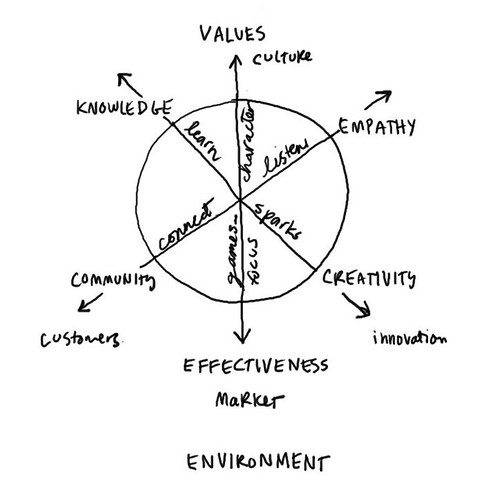A coworker recently forwarded a link to a posting in the Environmental Leader by Kathy Miller, mentioning that it related to some of my blog posts. In How to Engage in Sustainability with Higher Purpose, Dr. Miller points out the importance of corporate vision to sustainability, and recognizes that engaging people increases their commitment to the business and its goals. These are recurring themes in my thinking.
Evolutionary Thinking
Over the past 30 years I've worked for a Fortune 500 company, mid-sized engineering consulting firms, a state agency, a non-profit and now my own energy consulting firm. After experiencing a variety of management approaches, I have pinpointed six principles for engaging people in their work and the larger mission of an organization.
- Use an inclusive decision making process. People throughout the organization need to be part of the process for developing policies, budgets, schedules, products and communication. Develop a well organized process to effectively identify appropriate stakeholders, ensure that relevant perspectives are considered and provide clear channels for review and feedback both initially and post implementation. You want the process to clearly identify the individual who has the ultimate responsibility and authority for the decision.
- Give the benefit of the doubt. A fundamental tenant of our legal system is innocent until proven otherwise. Applying this same approach in the business world means we recognize that in almost all cases people have the right intentions, but mistakes happen. When a corporate decision is made that negatively affects personnel, feedback needs to be heard and changes made, but affected individuals should not presume that they have been intentionally wronged. Similarly, when an error is made in schedule, budget, work or communication, it should be viewed and treated as a mistake, not as an employee failing or intentionally undermining the effort. Accusations, anger, and frustration cost money, time and productivity and have zero positive contribution to engagement or profits.
- Recognize that work is, well, WORK. At times any job can be hard, boring, onerous, unrewarding, frustrating, or repetitive. Workplaces need to recognize this, provide outlets and address issues when they arise. A coworker recently shared her frustration at being required by a client to continue to use a process that is known to be dysfunctional. The issue has been raised and elevated several times over the three-year project, but nothing has changed. It can be hard to hear another’s frustration and know that the solution is not in your grasp. But if my response had been “it’s our job,” imagine how her frustration would only have grown. Instead our discussion resulted in identification of some small benefits to the approach and a modified way of dealing with the negative result of the flawed process. It wasn't perfect, but my coworker felt heard and my sensitivity to the burden on the project team imposed by the problem increased.
- Embrace work/life balance. As a consulting firm, Cx Associates is always looking to fill our new business pipeline, yet we have little control over the inflow of work. When the inflow warrants new hires, finding qualified personnel can be difficult. So, we often end up with more work than resources and people work overtime. This is profitable but not sustainable. While it is inevitable that people will need to put in extra hours, it is essential that people take breaks. Flexible schedules and generous personal time policies support people in gaining balance. Firms also need to ensure that people don’t just accumulate time off. Adopting policies that limit carry-over and proactively work to get people to take time off makes sense for people and companies.
- Share responsibility by sharing authority. I once worked for a client who was responsible for the development of a new ski area base lodge in Vermont. He worked for a large NYC-based organization and even though he was smart, competent and good at his job, he could not make a single decision without being second guessed by “the powers that be.” He left, his similarly competent replacement left and the project took twice as long as necessary to design and build. To successfully engage people in taking responsibility, verify they have the necessary skills and knowledge, then give them the authority to make the decisions necessary to manage their work and support them in the process.
- Create a respectful environment. When I started as an intern at Corning Glass Works, Amory Houghton approached my desk to say hello. I addressed him as “Mr. Houghton” and he responded that I should call him “Amo.” This was a clear statement to me that while he was the CEO and I was an intern, we were working together for the company. I refer to people I work with as coworkers, not as employees. While both terms are correct, reducing the verbal hierarchy shows respect for the individuals who contribute at many levels to the success of the organization.
Creating a workplace culture that values everyone takes time and practice. No one gets it right all of the time, but if they get the benefit of the doubt, learning can take place with every miss and engagement will increase sustainably over time.



